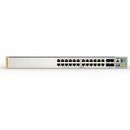Description
The Allied Telesis X530L-28GPX Layer 3 Switch is a robust, future-ready networking appliance designed to meet the demands of modern small to mid-size environments. Engineered to deliver high-performance Gigabit access with versatile 10 Gigabit uplinks, it enables seamless aggregation, distribution, and core connectivity in a compact, reliable chassis. Built to simplify network design while expanding capacity, the X530L-28GPX blends enterprise-grade routing, advanced switching features, and straightforward management to accelerate business outcomes. Whether you’re upgrading a campus backbone, establishing a dependable data center edge, or consolidating branch networks, this switch offers the reliability, security, and flexibility required to keep applications, voice, video, and data flowing smoothly. Its emphasis on wire-speed performance, scalable VLANs, and sophisticated QoS makes it an ideal backbone for multi-service networks, delivering consistent user experiences across critical workloads. With administrator-friendly operation, you can deploy, configure, and maintain the switch with confidence using trusted Allied Telesis management tools and proven protocols.
- High-density Gigabit access with scalable uplinks: 24 x 10/100/1000BASE-T ports paired with 4 x 1/10G uplinks provide ample access-layer connectivity and fast, scalable aggregation or distribution to the core. This layout supports flat or hierarchical designs, enabling growth without replacing core infrastructure.
- Layer 3 routing for efficient traffic distribution: The X530L-28GPX includes Layer 3 capabilities with static routing and dynamic routing support where applicable, enabling clean inter-VLAN routing and intelligent path selection across the network. IPv4 and IPv6 support future-proofs the platform for modern addressing schemes.
- Comprehensive security and reliability features: Built to guard networks against misconfigurations and threats, the switch provides ACLs, DHCP snooping, IP source guard, and robust management authentication. Along with standard logging and monitoring, these features improve visibility, control, and compliance across devices and services.
- Advanced QoS for critical applications: Policy-based routing, layered queuing, VLAN tagging, QoS classification, and traffic shaping ensure that voice, video, and essential data receive appropriate bandwidth and predictable performance even under congestion.
- Flexible management and dependable operation: Access and configure the device via a web-based GUI or command-line interface, with support for standard network management tools and protocols. The dual fixed power supplies enhance reliability, helping maintain uptime in demanding environments.
Technical Details of Allied Telesis X530L-28GPX
- Ports: 24 x 10/100/1000BASE-T for fast, flexible access connections
- Uplinks: 4 x 1/10G uplinks to support high-speed aggregation, distribution, or core connectivity
- Layer 3 routing: Includes static routing and dynamic routing support where applicable, enabling inter-VLAN routing and efficient path selection
- IP protocol support: IPv4 and IPv6 compatibility for forward-looking networking
- Security features: ACLs, DHCP snooping, IP source guard, and robust management authentication to safeguard the network
- Traffic management: Quality of Service (QoS) capabilities with policy-based routing, layered queuing, VLAN tagging, QoS classification, and traffic shaping
- Management interfaces: Web-based GUI and Command-Line Interface (CLI) for flexible administration
- Network design flexibility: Suited for campus backbones, data center edge, and multi-service networks requiring reliable, scalable performance
- Power redundancy: Dual fixed power supplies for improved uptime and resilience
How to install Allied Telesis X530L-28GPX
- Prepare the installation area: mount the switch in a standard 19" rack or place it on a stable, well-ventilated surface with adequate airflow to prevent overheating.
- Connect power for reliability: attach both of the dual fixed power supplies to properly rated power sources and verify that any redundant power indicators show healthy status.
- Connect network devices: use the 24 Gigabit ports to link access-layer devices (workstations, printers, IP phones, wireless controllers, etc.) and connect the 4 high-speed uplinks to your aggregation, distribution, or core switches to form a scalable network topology.
- Configure management access: connect a management workstation to the switch, and access the web GUI or CLI. Assign an IP address per your network policy or enable DHCP on the management interface as appropriate for your environment.
- Set up core features: configure VLANs, inter-VLAN routing, IPv4/IPv6 addressing, QoS policies for critical applications, security controls (ACLs, DHCP snooping, IP source guard), and enable logging and monitoring to maintain visibility and control. Save the configuration and monitor the switch to ensure stable operation.
Frequently asked questions
- What is the port layout of the X530L-28GPX? It features 24 x 10/100/1000BASE-T ports for access connectivity and 4 x 1/10G uplinks for high-speed aggregation and core connections.
- Does it support Layer 3 routing? Yes. The switch provides Layer 3 routing capabilities, including static routing and dynamic routing support where applicable, as well as inter-VLAN routing for efficient traffic distribution. It also supports IPv4 and IPv6.
- What management options are available? It can be managed via a web-based GUI or a command-line interface (CLI), offering compatibility with standard network management tools and protocols for easy configuration and monitoring.
- Is there power redundancy? Yes. The model includes dual fixed power supplies to help ensure continuous operation and improve uptime in critical deployments.
- What deployment scenarios is this switch best suited for? It is ideal for small to mid-size networks requiring a reliable Layer 3 backbone or edge switch, including campus backbones, data center edge, and multi-service networks that need scalable access, robust routing, and QoS-driven performance.
Customer reviews
Showing - Of Reviews


